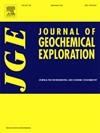Spatial distributions, potential sources, and ecological risks of heavy metals in stream sediments in Zambia
IF 3.4
2区 地球科学
Q1 GEOCHEMISTRY & GEOPHYSICS
引用次数: 0
Abstract
The ecological risk assessment and source identification of heavy metals (HMs) are significant for resource utilization and food security. This study aims to assess the spatial distributions, potential sources, and ecological risks of HMs in stream sediments in Zambia. Using 735 samples collected from stream sediments across the country and methods such as inductively coupled plasma mass spectrometry (ICP-MS), atomic fluorescence spectrometry (AFS), and X-ray fluorescence spectrometry (XRFS), this study determined the concentrations of the seven HMs, i.e., arsenic (As), chromium (Cr), copper (Cu), mercury (Hg), nickel (Ni), lead (Pb), and zinc (Zn). The spatial distributions of these HMs were determined using a Geographic Information System (GIS), and their ecological risks were accessed based on the analytical results of their potential sources. Additionally, this study explored the relationships between mining activities and regions with high heavy metal (HM) concentrations based on the statistical analysis of the HM concentrations and geology of the study area. The results indicate the stream sediments in Zambia exhibit average As, Cr, Cu, Hg, Ni, Pb, and Zn concentrations of 1.49 × 10−6, 19.34 × 10−6, 12.12 × 10−6, 12.70 × 10−9, 7.13 × 10−6, 12.52 × 10−6, and 16.30 × 10−6, respectively. The analytical results of the geoaccumulation index (Igeo) and potential ecological risk index (PERI) reveal the presence of relatively high As and Cu concentrations, especially in Copperbelt and North-Western provinces and areas surrounding Lusaka—the capital of Zambia. The HM contamination in stream sediments in Zambia is primarily caused by Cu and gold (Au) mining. This study exemplifies how to determine potential sources and ecological risks of HMs in stream sediments, holding important implications for nation-scale environmental contamination prevention and land utilization planning.
赞比亚河流沉积物中重金属的空间分布、潜在来源及生态风险
重金属生态风险评价和来源识别对资源利用和粮食安全具有重要意义。本研究旨在评估赞比亚水系沉积物中HMs的空间分布、潜在来源和生态风险。采用电感耦合等离子体质谱法(ICP-MS)、原子荧光光谱法(AFS)、x射线荧光光谱法(XRFS)等方法,对全国水系沉积物中砷(as)、铬(Cr)、铜(Cu)、汞(Hg)、镍(Ni)、铅(Pb)、锌(Zn)等7种HMs的浓度进行了测定。利用地理信息系统(GIS)确定了这些有机污染物的空间分布,并根据潜在污染源分析结果了解了它们的生态风险。此外,通过对研究区重金属浓度和地质条件的统计分析,探讨了采矿活动与重金属高浓度区域的关系。结果表明,赞比亚水系沉积物中As、Cr、Cu、Hg、Ni、Pb、Zn的平均浓度分别为1.49 × 10−6、19.34 × 10−6、12.12 × 10−6、12.70 × 10−9、7.13 × 10−6、12.52 × 10−6和16.30 × 10−6。地质累积指数(Igeo)和潜在生态风险指数(PERI)分析结果显示,铜带和西北省份以及赞比亚首都卢萨卡周边地区存在较高的As和Cu浓度。赞比亚河流沉积物中的HM污染主要是由铜和金(Au)开采引起的。该研究举例说明了如何确定水系沉积物中HMs的潜在来源和生态风险,对全国范围内的环境污染预防和土地利用规划具有重要意义。
本文章由计算机程序翻译,如有差异,请以英文原文为准。
求助全文
约1分钟内获得全文
求助全文
来源期刊

Journal of Geochemical Exploration
地学-地球化学与地球物理
CiteScore
7.40
自引率
7.70%
发文量
148
审稿时长
8.1 months
期刊介绍:
Journal of Geochemical Exploration is mostly dedicated to publication of original studies in exploration and environmental geochemistry and related topics.
Contributions considered of prevalent interest for the journal include researches based on the application of innovative methods to:
define the genesis and the evolution of mineral deposits including transfer of elements in large-scale mineralized areas.
analyze complex systems at the boundaries between bio-geochemistry, metal transport and mineral accumulation.
evaluate effects of historical mining activities on the surface environment.
trace pollutant sources and define their fate and transport models in the near-surface and surface environments involving solid, fluid and aerial matrices.
assess and quantify natural and technogenic radioactivity in the environment.
determine geochemical anomalies and set baseline reference values using compositional data analysis, multivariate statistics and geo-spatial analysis.
assess the impacts of anthropogenic contamination on ecosystems and human health at local and regional scale to prioritize and classify risks through deterministic and stochastic approaches.
Papers dedicated to the presentation of newly developed methods in analytical geochemistry to be applied in the field or in laboratory are also within the topics of interest for the journal.
 求助内容:
求助内容: 应助结果提醒方式:
应助结果提醒方式:


